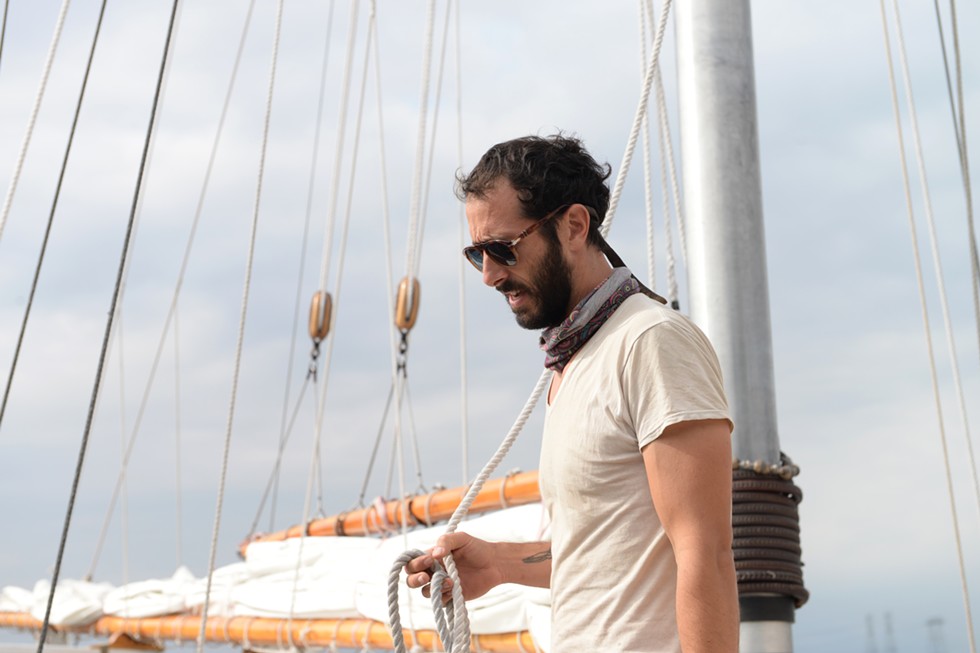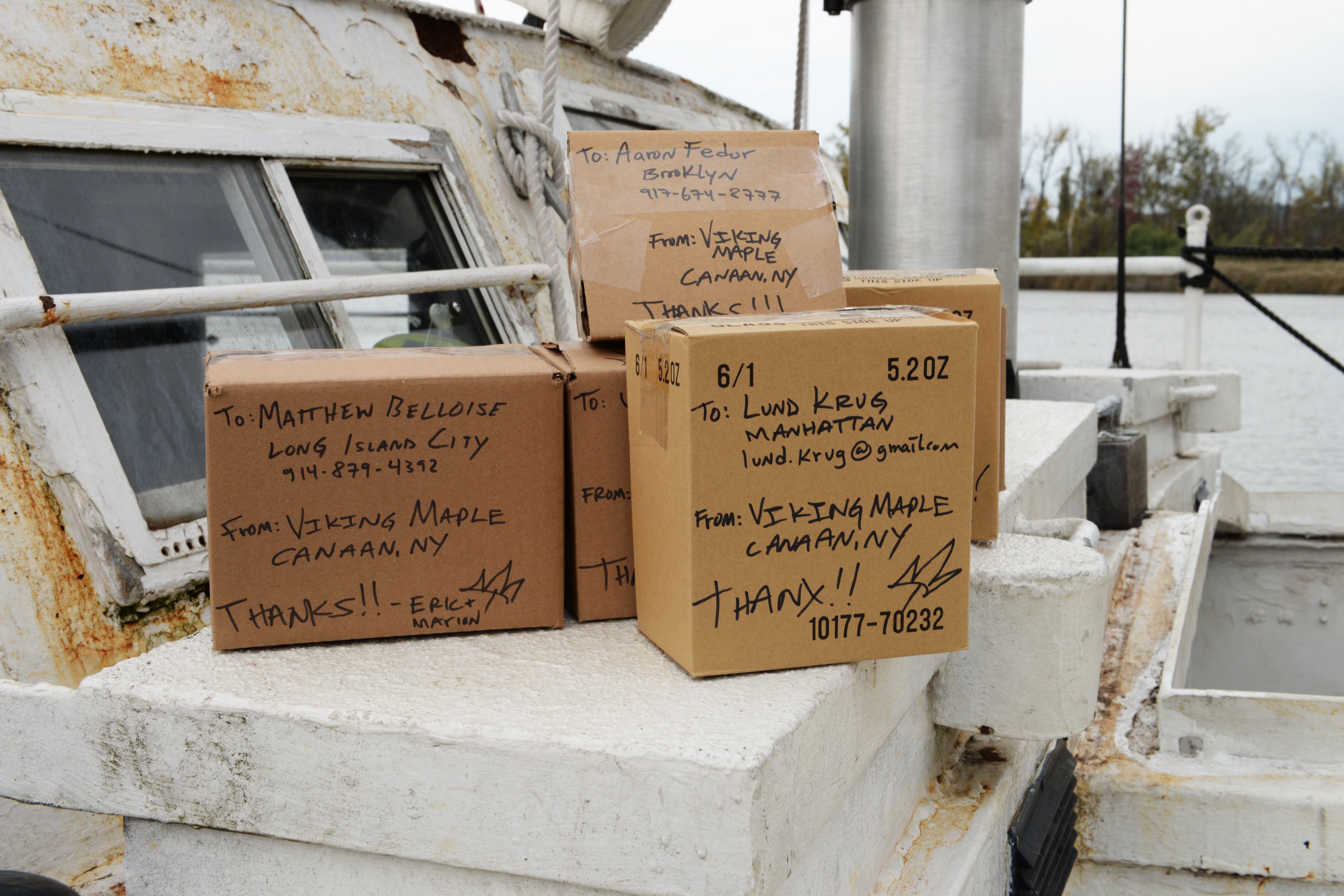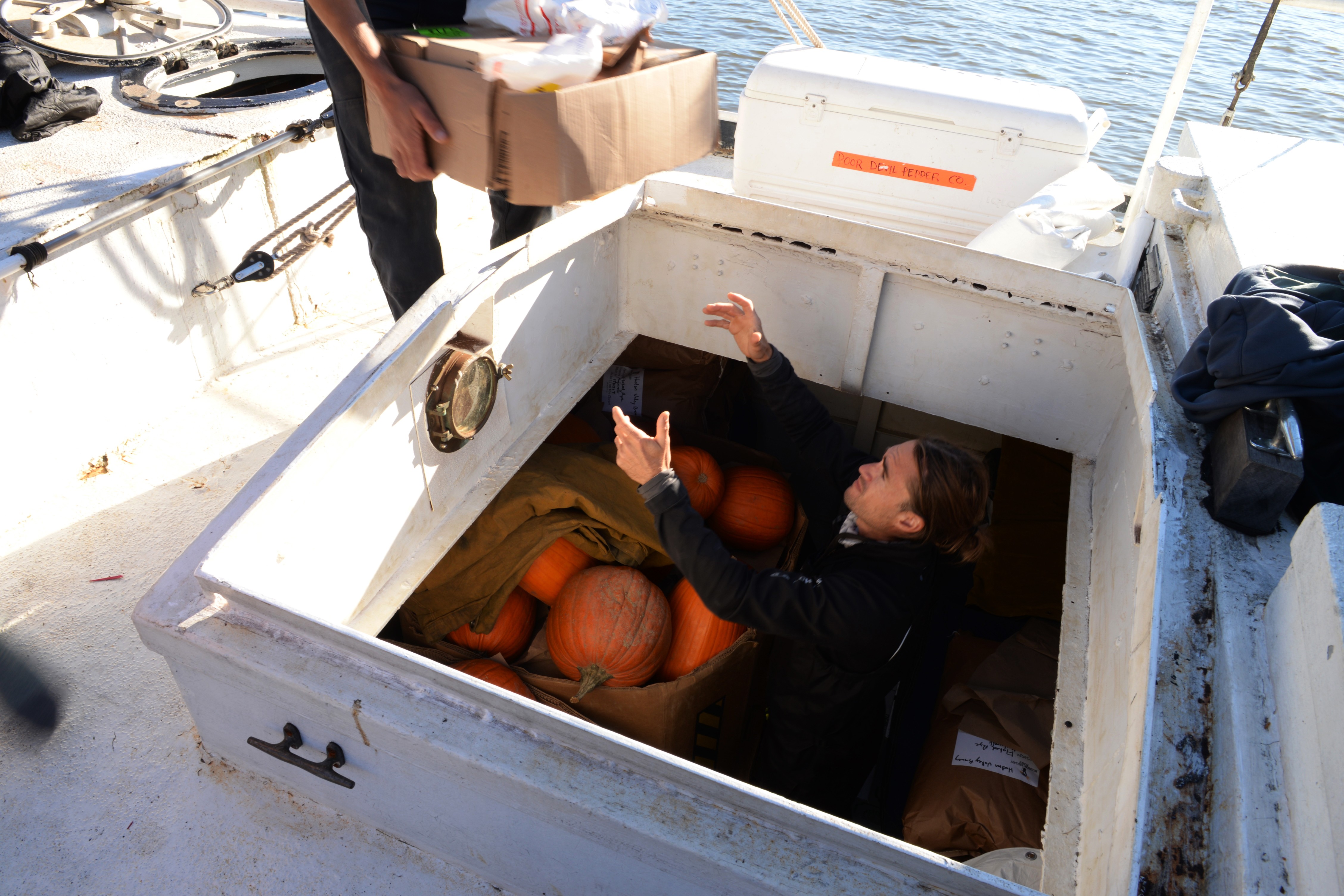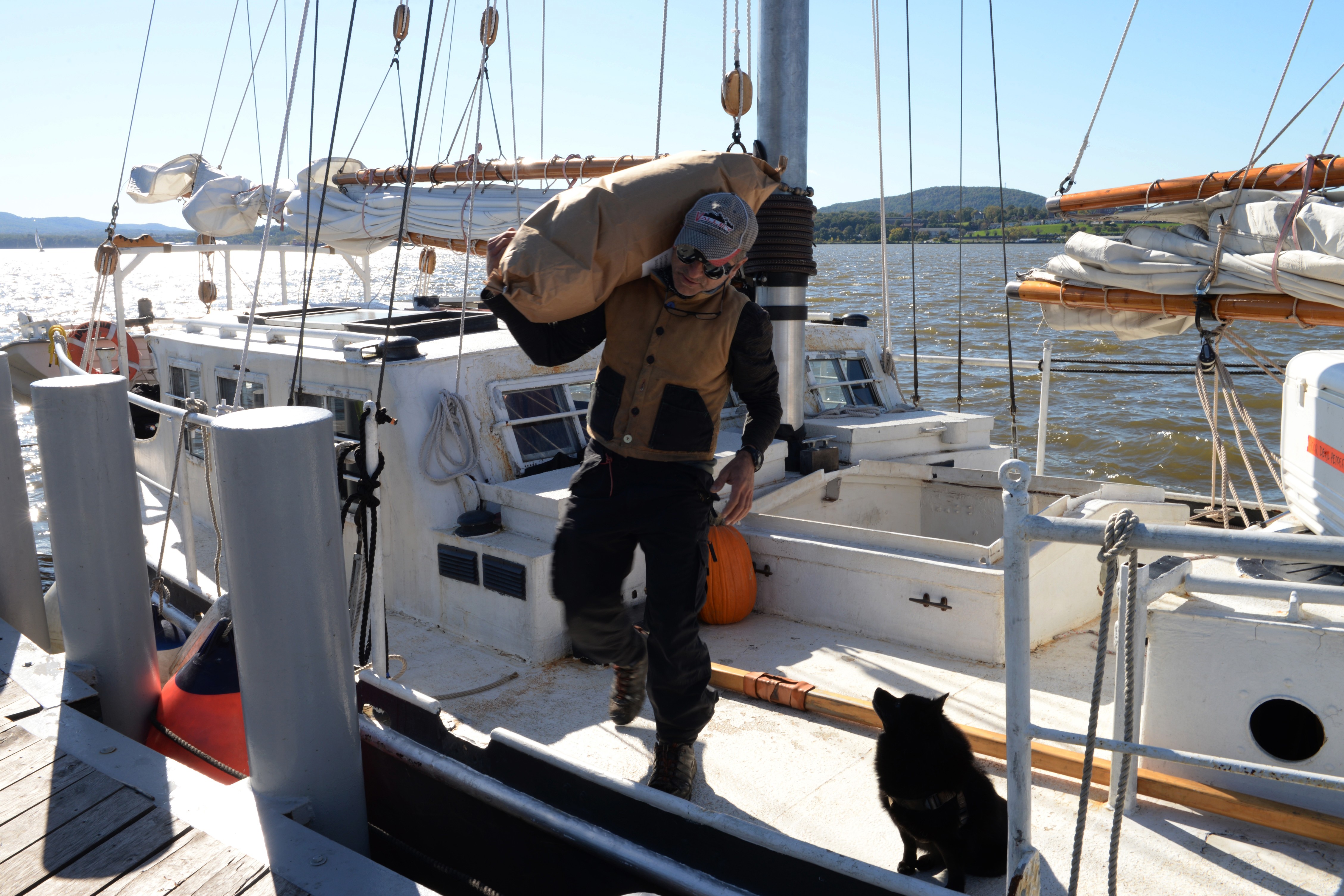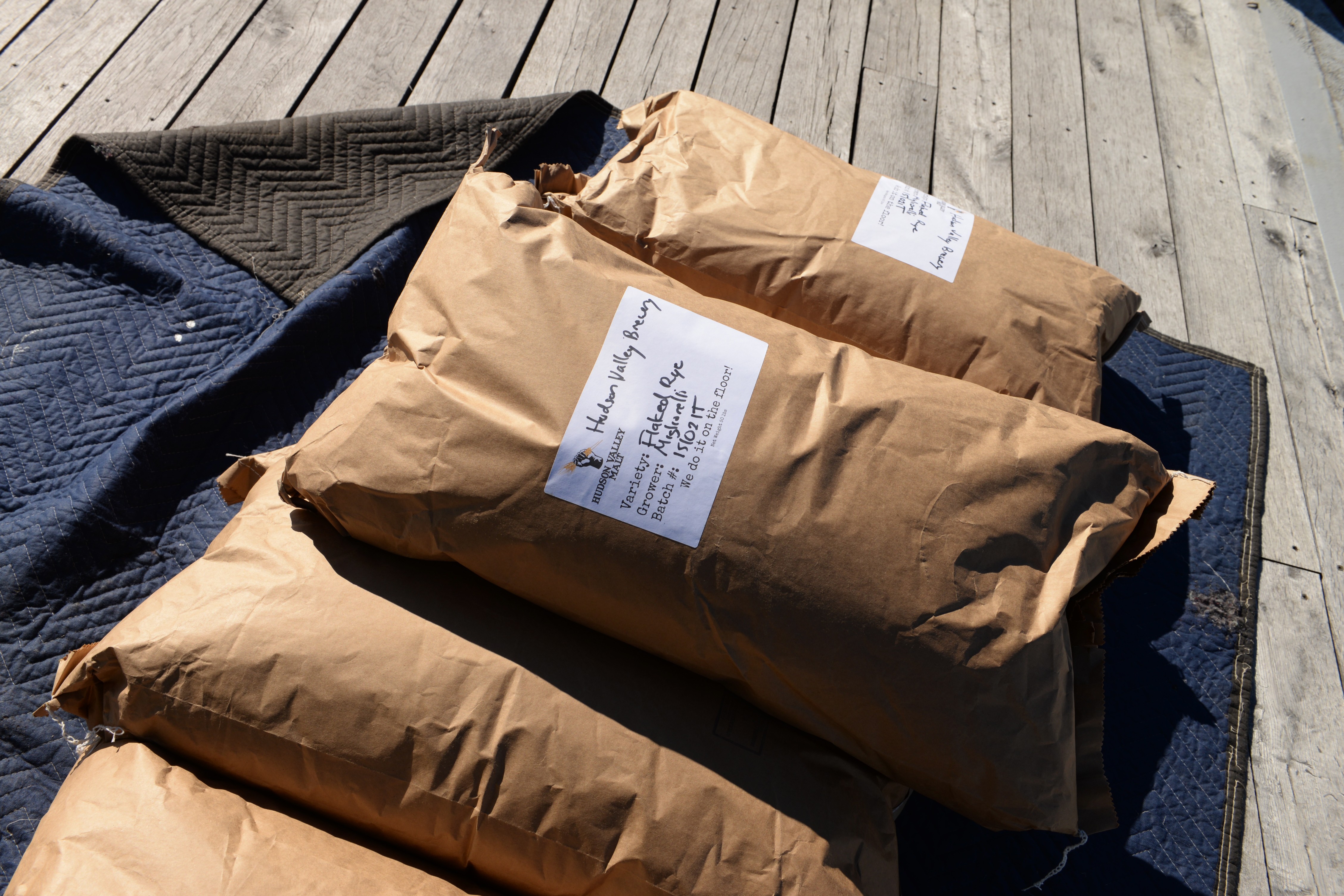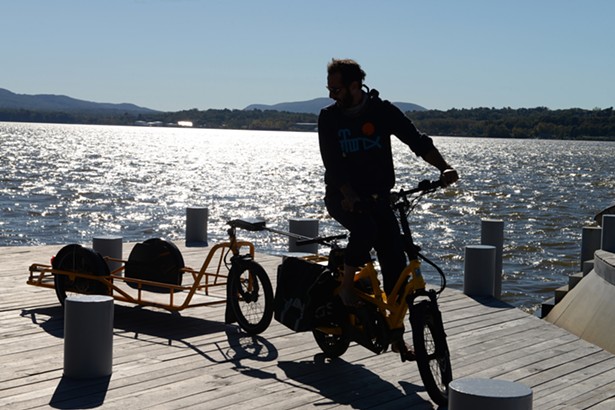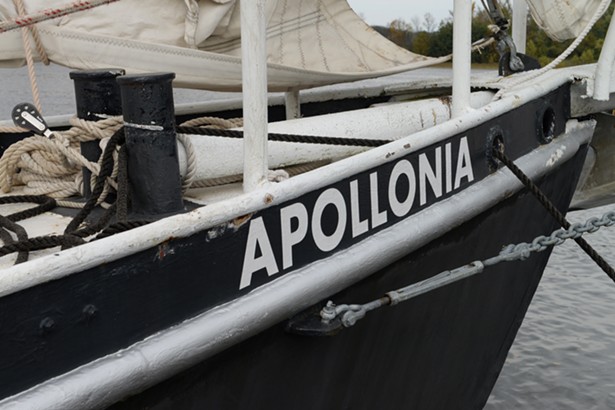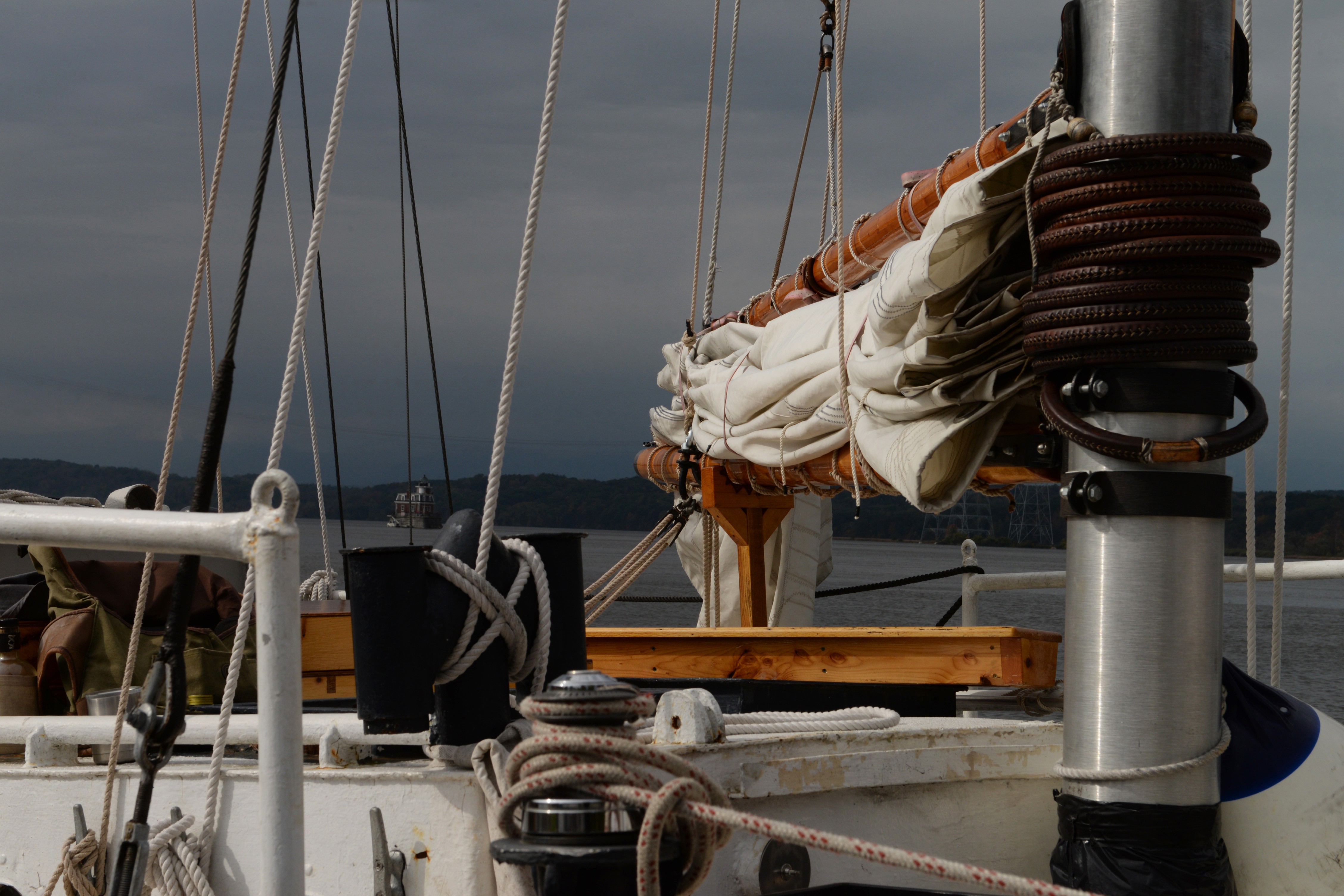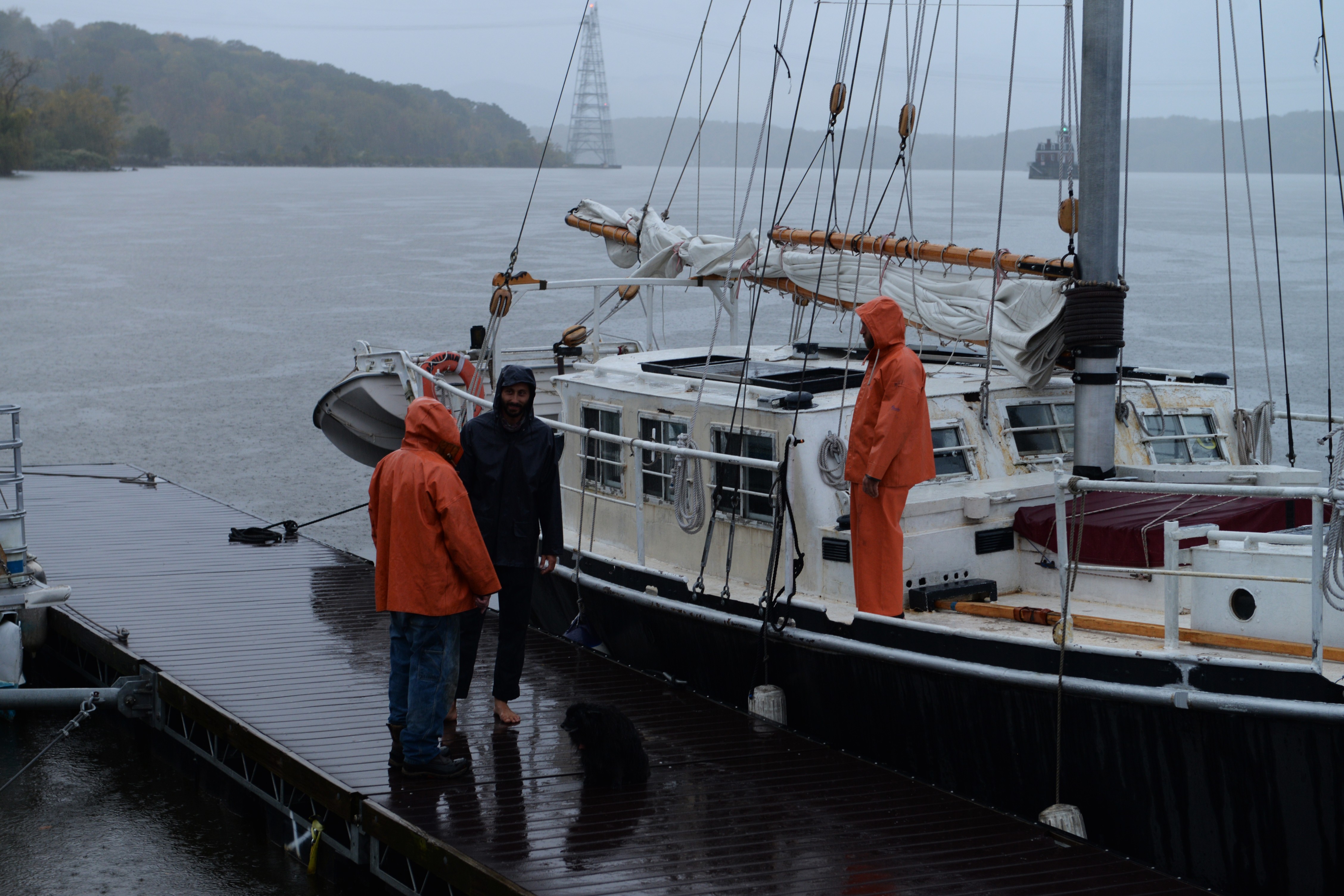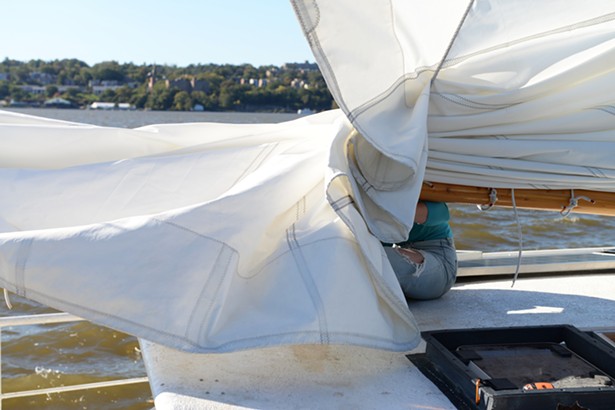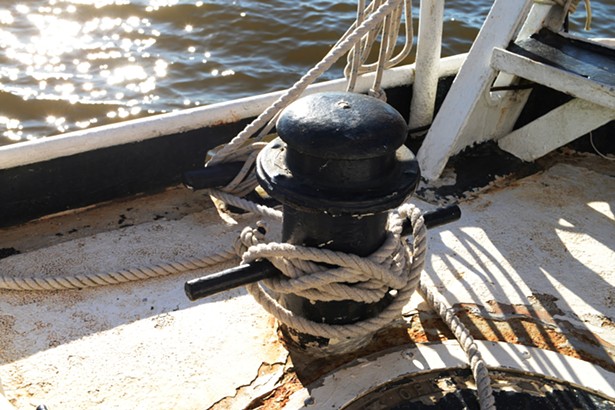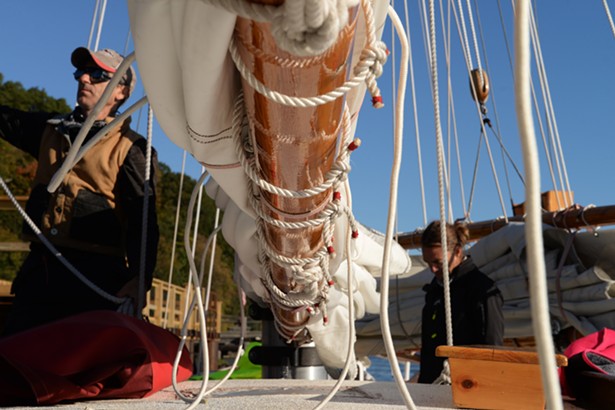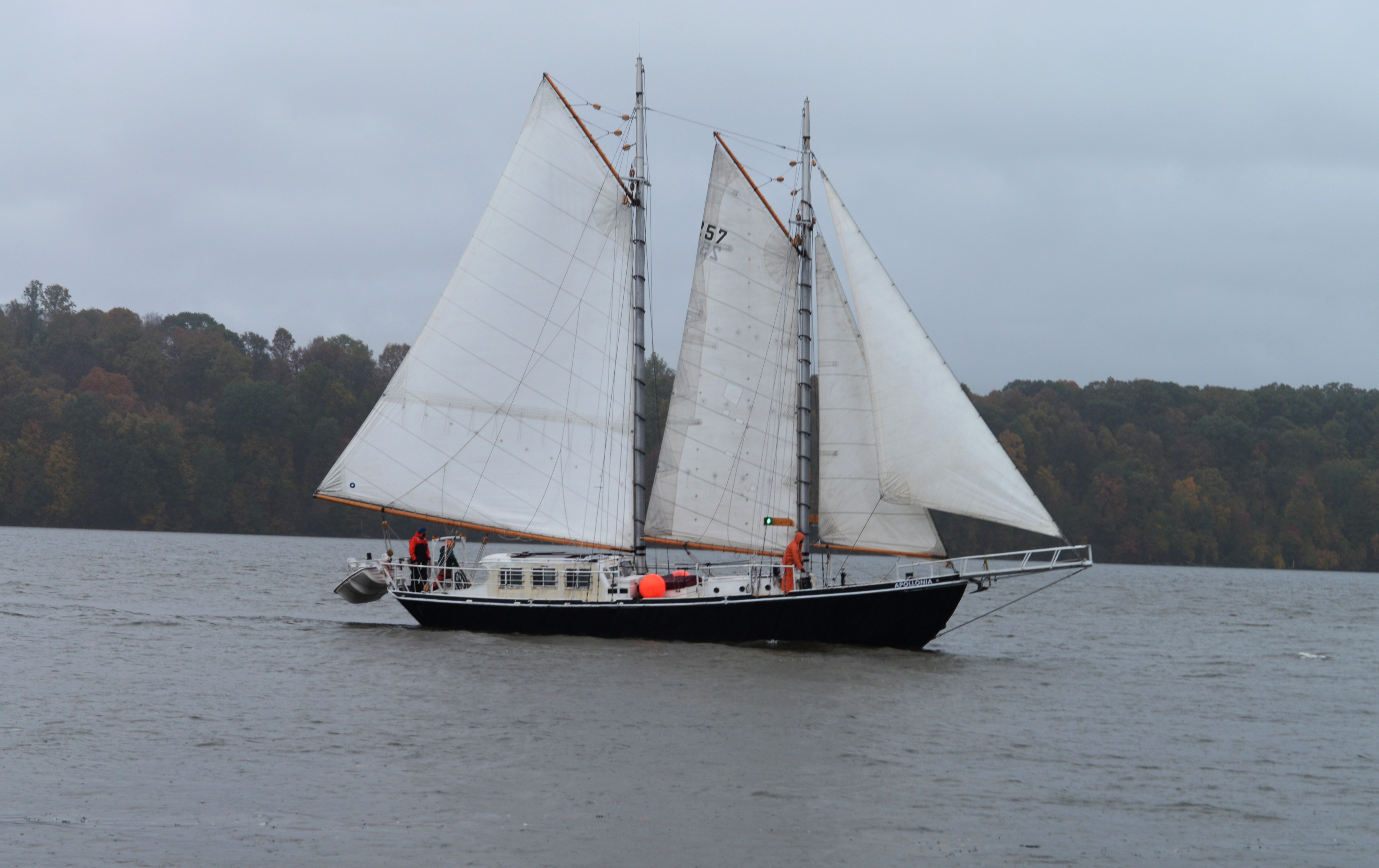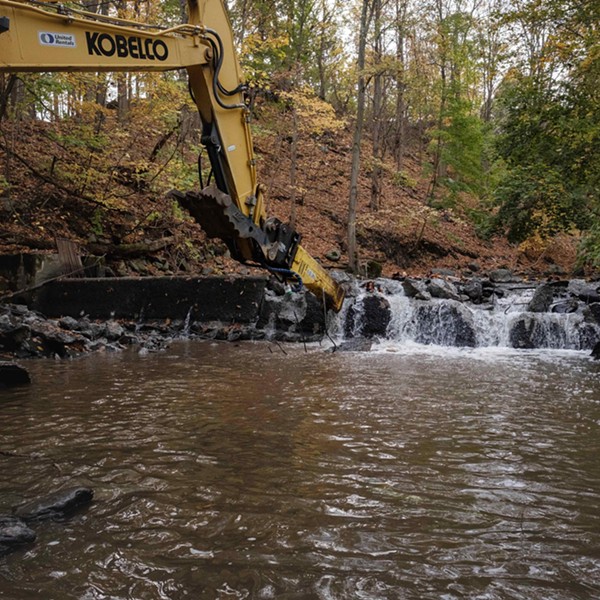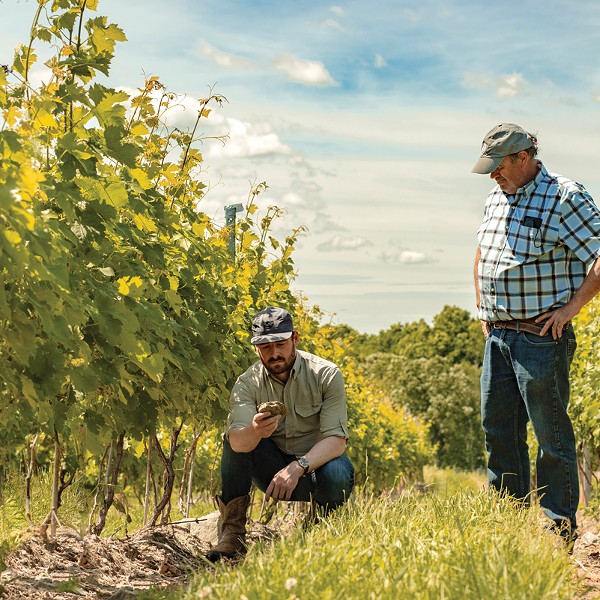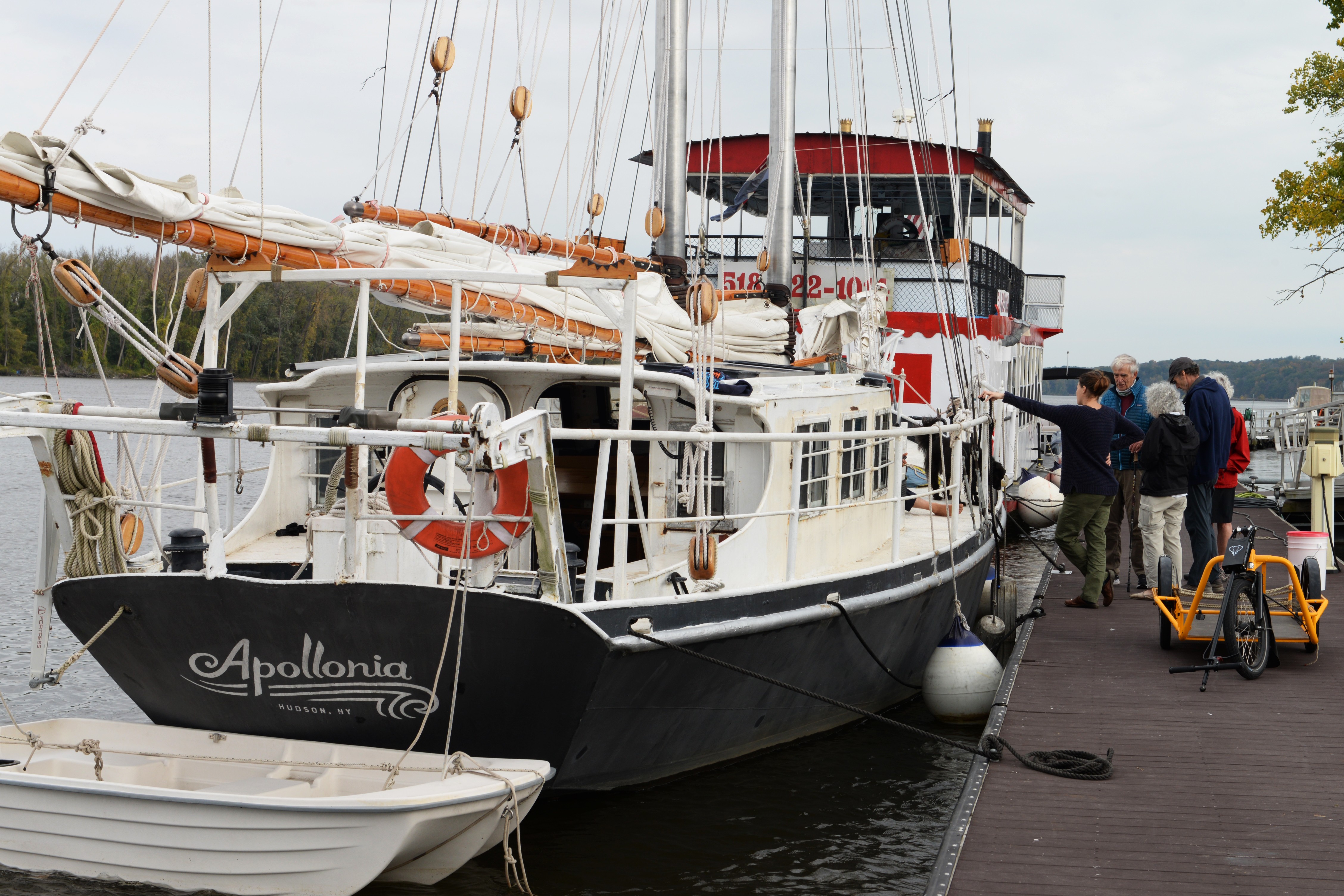
This story is Part II of a series on local business and climate solutions, sponsored by the Solutions Journalism Network. Part I covered solar grazing and the revival of sheep farming in New York. We are seeking reader feedback via a survey at the bottom of the article.
What’s it worth to prove to the world that sail freight works? To sail five times round trip from Hudson to New York Harbor in a 64-foot steel schooner built in 1948, carrying 65,000 pounds of grain and malt, pumpkins and peppers, oak logs and barrel-aged rye? To contend with fickle winds and forbidding ports with a crew of four, loading and unloading 50-pound sacks with old-fashioned muscle power and a jury-rigged jib sail cargo slide, and delivering them the last mile on bicycles? To bring the old skills and customs of sail shipping back to waterfronts up and down the Hudson River, one port at a time?
Through one lens: $86.75.
That’s the value the New York State Department of Environmental Conservation assigns to the prevention of 1,530 pounds of carbon emissions, a lowball estimate of the greenhouse gasses the Hudson-based schooner Apollonia kept from being released into the Earth’s atmosphere in 2021, and possibly the most dismaying figure I’ve ever calculated for a story. But there’s more to a zero-carbon economy than raw numbers reveal, and the benefits of building one go far beyond the balance sheet.
In 2020, the Apollonia, a merchant sailing schooner from Baltimore that spent 30 years languishing in a suburban backyard, set forth to ply the Hudson River as a cargo ship. Her humble goal: to explore the possibilities of sail freight. In 2021, she proved her logistical mettle. In her third season, she’ll start to put a real business model into practice.
If the Apollonia proves her business viability, her captain Sam Merrett, the small crew of sailors and financial backers, and a growing ecosystem of farm and waterfront businesses, port partners, and community supporters will have done more than spare a few hundred gallons of diesel fuel from burning each year. They’ll have harnessed a desire to take action on climate change, and used it to propel the growth of a passionate and purposeful local food web up and down the river. Not every solution to the carbon problem aims to bring transformative change to whole communities and industries. This one does.
It won’t happen overnight. That’s okay with Merrett: For someone who talks fast, works hard, and always seems to have a thousand projects going at once, he is comfortable with slow paths. “We’ll get there schooner or later,” he likes to say, even if it gets a groan.
Modern Sail Freight 2.0
The Apollonia wasn’t the first ship to sail down the Hudson this century with a cargo of freight bound for New York City markets. That honor belongs to the Ceres: a hand-built, two-masted, flat-bottomed 39-foot sailing barge, and the heart of the quixotic Vermont Sail Freight Project.
In October 2013, the Ceres took her first cargo voyage with 15,000 pounds of produce from the shore of Lake Champlain, through the 11 locks of the 60-mile Champlain Canal, and on down the Hudson from Troy to New York City. Propelled by the wind, a $13,000 Kickstarter campaign, and the sheer will and enthusiasm of Vermont rice farmer Erik Andrus, the Ceres stayed afloat for two seasons and attracted a barrage of media attention. The food movement wanted to believe in Andrus’s dream—and so did The New Yorker, The New York Times’s T magazine, Civil Eats, and the upstart young media-savvy farmers of The Greenhorns. But it was not to last.
Despite the glowing publicity, a combination of daunting port and market logistics, surprise insurance bills, and the impossibility of single-handedly reviving an entire farm-to-ship-to-market economy from Lake Champlain to Gowanus quickly sank the Vermont Sail Freight Project. After the 2014 season, Andrus folded up the Ceres’s sails and stowed her away in his barn; in 2019, he put the ship up for sale on Craigslist, “if not as a boat, maybe as a terrestrial tiny house conversion or perhaps a Viking funeral prospect.” (Andrus politely declined to speak to The River about his experiences as a respected founding father of the modern sail freight movement. “I don’t really enjoy talking about it to be honest,” he wrote to me.)
It’s hard not to get swept up in the romanticism of sailing. As Ratty of Wind in the Willows famously said, there is nothing half so much worth doing as simply messing about in boats—although it’s worth remembering that Ratty’s boat sank. Speaking with the relentlessly energetic Merrett and his crew at the Kingston dock by the Hudson River Maritime Museum as they disembarked from their last run of 2021, I felt a pang of wishing that I had lived in another era. It was a beautiful crisp October day, and the sun sparkled on the Rondout and on the Apollonia’s varnished wooden spars. I wanted to believe in sail freight. I wanted the Hudson to be alive with tall ships once more, like it was two centuries ago. I had to remind myself to keep asking: Is this real?
That remains to be seen. The first couple of years for any new business are usually unprofitable and precarious. But it might work—even if a price on the carbon the Apollonia is saving wouldn’t cover the cost of a day’s sail.
Moving Malt
If the Apollonia thrives, it might have Dennis Nesel to thank. Nesel, who runs Hudson Valley Malt in Germantown with his wife Jeannette Spaeth, is on his own mission to revive another pre-industrial craft that has all but vanished from the region. In 2015, when the pair set out to make malt from local barley, wheat, and rye using ancient and labor-intensive floor malting techniques, people told Nesel he was crazy.
That’s pretty much what Nesel told Merrett too, when the Apollonia’s captain first approached him with the idea of sailing his malt down the river to local breweries. “As a businessman, I first thought, ‘Well, I don't have time for this,’” Nesel says. “But I liked his enthusiasm. He never gave up.”
In March 2020, as Merrett was preparing for the Apollonia’s maiden freight voyage, the pandemic was forcing cutbacks at the local breweries and distilleries that buy Nesel’s malt. Orders were down. Uncertainty and fear were way up. Nesel thought it was a terrible time to launch something new. But Merrett kept trying, indefatigable, and eventually local documentary filmmaker Jon Bowermaster gave him an assist.
I love this. I freaking love it, because it’s real. Are these guys nuts? Are they romantics?
Dennis Nesel“Jon lives in the same town here, and he called me up,” Nesel says. “He said, ‘Dennis, wouldn’t it be great to be part of something good right now, with all this shit going on?’” He thought about it. It would.
Another aid to Merrett’s cause: Nesel was already frustrated with his shipping options. According to him, it costs $254 to ship a pallet that might hold a ton or two of malt from Germantown to a downstate brewery by truck, and that cost is paid by the brewer who orders it. But as the supplier, Nesel chooses the shipping, and if anything goes awry, he’s responsible. “I was sick and tired of putting fresh malt onto a truck for a brewery in Brooklyn and having it end up in Syracuse, or having it end up damaged,” he says. He decided to take a chance and ship a little with Merrett.
The partnership between the Apollonia and Hudson Valley Malt is now the core of the sail freight project. Of the 65,000 pounds of goods the Apollonia shipped on five runs down the Hudson in 2021, more than half—33,955 pounds—was Nesel’s malt, bound for local breweries and distilleries. Another 11,500 pounds were Catskill mountain oak and maple logs, destined to be made into shiitake mushroom growing kits at Red Hook’s RETI Center in Brooklyn.
The Apollonia carried a variety of smaller cargoes last year too: grapes, peppers, soap, rope, CBD products, hot sauce, even solar panels and a 19th-century printing press. Some of it was bound for waterfront markets and places where individual customers could pick up pre-ordered goods. In 2022, the ship will offer a “boat box,” modeled after community supported agriculture programs, that lets people buy a share of the Apollonia’s freight for the season. Direct sales to individuals could end up being an important stream of revenue for the project, and help spread the word about its educational mission. But the malt is the backbone, and possibly the key to Hudson River sail freight’s long-term survival.
By focusing on large cargo pre-ordered in bulk, Merrett may end up avoiding some of the pitfalls that doomed the Vermont Sail Freight Project. Andrus and his crew relied on large retail markets in New York City to sell thousands of pounds of produce at once, and discovered the hard way that showing up with goods to sell isn’t enough. “After a week of making calls and deliveries, quite a lot of unsold goods still remained,” Andrus wrote in 2014. “It became clear to me that having a plan to deal with delivered cargo that went beyond a few markets and a few rounds of calls to restaurants and shops was going to be necessary.”
Two seasons of working with the Apollonia and the waterfront breweries have made a convert of Nesel, and the collaboration has convinced him to swap out the non-recyclable heavy plastic sacks he used to ship his malt in for compostable paper. When sail snafus happen—like the time Merrett and crew sailed for Beacon with a load of 2,500 pounds of malt bound for the Hudson Valley Brewery, only to be told en route that they couldn’t dock—captain and crew hustle to make it work. In that case, making it work involved a last-minute dock switch to Newburgh, where the malt was loaded onto electric cargo bicycles and pedaled across the Newburgh-Beacon bridge to its destination.
“You know what? I love this. I freaking love it, because it’s real,” Nesel says. “Are these guys nuts? Are they romantics? That’s exactly why I was reluctant in the beginning. But it is legit. I trust every time I put a load on that schooner with Sam that it’s going to get there.”
Nesel figures that he produced 800,000 pounds of malt in 2021. A little envelope math reveals that in five shipping runs last year, Apollonia shipped just over 4 percent of his product. It’s not a large number, but it’s a real one. Consider this: If every business in New York State were to decarbonize 4 percent of its fossil-fueled activity every year, we’d have a zero-carbon economy in the state by 2047, three years ahead of the goal enshrined in New York’s 2019 climate law.
For the waterfront breweries on the Apollonia’s route, malt shipping has been free so far, and that needs to change. Merrett decided to use the 2021 season to figure out what was logistically possible before charging for malt delivery. But if the Apollonia is to succeed in the long run, she needs to cover her costs—and what sail freight saves on diesel fuel, it more than spends on labor. A trip that a truck could do in a few hours with one driver takes the Apollonia several days with a paid crew of four.
Hoist a Sail—And a Glass
Last fall, Hudson Valley Brewery in Beacon brewed a special beer to celebrate the greening of the local economy: Glimmer, a farmhouse lager brewed with sail-shipped malt from Nesel, and released in collaboration with Bread Alone in honor of its new 8,000-square-foot zero-carbon bakery in Boiceville.
“What we work with Sam on is focusing on creating a little more storytelling around the product, or around the process,” says brewmaster Michael Renganeschi. In 2021, Renganeschi says, the Apollonia delivered about 6,000 pounds of malt to the brewery, enough to supply a quarter of Hudson Valley Brewery’s New York State-based farm brewing program, which itself makes up about half of the brewery’s overall production.
With a total output of about 3,500 barrels in 2021, Hudson Valley Brewery is one of the larger craft breweries in the area, with one foot in the hyperlocal world of New York farm brewing and another on the international stage. The brewery has two licenses from the state: a standard brewing license, under which they brew more mass-produced beers in a separate facility, and a farm brewery license, under a program created in 2013 that lowers the license fee for brewers (and now distillers, too) who base their products on New York State-grown farm ingredients.
When state legislators created the farm brewery program, they probably didn’t foresee the creation of a sail freight malt-shipping network along the Hudson. But farm brewery licensing sparked a wave of new craft breweries and increased New York’s hop and barley production, while creating new opportunities for malters like Nesel to fill critical links in the local supply chain, and improving the Apollonia’s odds of success. Renganeschi calls the license “one of the best agricultural and local economy decisions New York State has made.”
Hudson Valley Brewing isn’t the only local producer using the Apollonia as a pretext to make special brews and batches. There’s the Malt Overboard from Five Boroughs Brewing, the Apollonia Extra Pale from Big Alice in Queens, and released this month, the North River Rye from Newburgh’s Spirits Lab, which has spent almost a year aging on board the Apollonia in oak barrels. It’s green marketing, sure—but it’s also an opportunity to celebrate, collaborate, and build community among makers and small business owners up and down the waterfront.
Renganeschi says he’s hoping to source even more malt from the Apollonia in 2022, and to make more special sail freight brews. “I’ll definitely do some beers that are specifically for the boat.” He’s excited about the prospect of making those decisions “the hard way”—which to him, as a brewmaster, means letting weather, crops, and the availability of ingredients shape the final product.
Sail freight brews might also be critical to the Apollonia’s business plan. For 2022, Merrett plans to charge breweries a standard fee, competitive with land-based shipping, and also work with them to share revenue from joint events held along the waterfront to celebrate sail shipping and local brewing. “I strongly believe in creating revenue streams that are shared between us and our shipping partners,” he says. “If we just charge on par with trucks and stuff like that, it’s not going to cover all of it. But the events have huge potential.”
Toward Better Ports
Some of the project’s impacts are being felt even if they can’t easily be counted. The Apollonia is bringing freight back to little river ports that have not seen commercial activity in decades. It’s a learning curve for everyone involved, Merrett says.
“The normal boat thing is, I live somewhere, and I leave one dock and I go in a circle, and I go back to that same spot on the dock,” he says. Accommodating cargo ships is more challenging, but it used to be done all the time, and it could again. “We’re reminding them of the value of the infrastructure they have.” Just by traveling up and down the river, negotiating with managers of small waterfront ports about the logistics of unloading cargo, the Apollonia is slowly making the Hudson a friendlier route for commercial traffic again, with help from her last-mile-logistics partners, the cargo bicycle company Revolution Rickshaws.

I’m grappling every day with how to move forward with what we’re doing.
— Sam Merrett
At least one place made it easy on them: Milton, a little waterfront hamlet in the Ulster County town of Marlborough, where a $1.6 million pier project was just completed last fall. The town reached out to the Apollonia, and Merrett was eager to connect with several local farms in easy bicycle-cargo distance: Hepworth Farms for peppers and pumpkins; Breezy Hill Orchard for apples, grapes, and cider; Sycamore Farms for pumpkins and squash. “If you have this brand new pier and nobody uses it, then people start to question it. But we had the opposite happen, where the second it was built, we were there.”
Milton was historically a port where table grapes were loaded onto schooners, before it became a more industrial pier for oil tanks, and later fell out of use. “Now it has been rebuilt as what I think is very exciting,” Merrett says. “This kind of hybrid modern waterfront, somewhere between recreation, commerce, and education”—an intersection where a modern sail freight project is right at home.
The Unholy Supply Chain
In the past two years, ordinary shipping at scale in the US has become a nightmare, in ways that go far beyond its massive carbon footprint. Efforts by government and big business to push just-in-time logistics have weakened both the workforce and the infrastructure of moving goods around. Recently, pandemic disruptions on top of decades of deregulation have strained brittle supply chains to the breaking point, leaving ports clogged with backed-up goods, pushing up the cost of warehouse space, and jacking ocean shipping costs more than tenfold in just a few years. More than 60 percent of the world’s goods now travel by container ship, a system that was created in the 1950s to save on port labor, and has since spurred an almost unrecognizable transformation of the world’s ports.
It’s a system Steven Woods would love to disrupt. An educator at the Hudson River Maritime Museum with a military logistics background, Woods recently wrote a master’s thesis dedicated to calculating what kind of fleet, infrastructure, labor, and policy environment it would take to supply the New York metropolitan area entirely with food by sail freight. His pole star is a 1929 book by Walter Hedden called How Great Cities Are Fed, a meticulous account of urban food-shipping logistics that coined the word “foodshed.”
“If we put the resources in the US to work, we could build the fleet that would feed New York in 13 years,” he says. “You have to change your foodways and how you feed people to do sail freight. But that’s how we fed people for thousands of years.”
While Merrett deals with the day-to-day tribulations of sail freight, Woods has his eye on the bigger picture. As he puts it: he’s in the food movement movement. “Sail freight, even in very small vessels, is more efficient than you’d think. When you look at an inland or coastal route, almost everyone’s discussing ships displacing ships, but that’s not the case here. It’s ships displacing trucks and trains.”
Through the museum on the Rondout, where Merrett also works part-time, Woods is working on getting more people involved in solving the problems of small-scale sail freight. This May, the museum will host a Grain Race, in which vessels will compete to see who can haul the most ton-miles of grain using the least amount of fuel and grid power. In November, the museum will host a conference on inland and coastal sail freight, in collaboration with the Apollonia and the local Center for Post Carbon Logistics.
Alternate Universe Problems
Calculating carbon impact requires looking at more than just fuel efficiency. Take the case of the Grain de Sail, a sleek and modern French sailing vessel, built to exacting specifications with modern cargo in mind. She is tiny compared to the container ships that dominate transatlantic shipping, but her climate-controlled hold can store 50 tons of palletized freight on the triangular route from St. Malo to New York to the Dominican Republic, more than the Apollonia managed to haul across her entire season.
It’s hard to quantify the carbon impact of a ship like the Grain de Sail. As a conveyor and marketer of luxury goods—French wine and chocolate, promoted by on-board tastings at the dock and branded with a sail freight label—it’s possible the ship is creating some of its own markets, rather than displacing its own weight in carbon-intensive transatlantic shipping.
Judging the real-world impact of climate solutions often involves “additionality problems,” which seek to calculate the difference between the world we live in—where the solution is deployed—and an alternate universe, where it never existed. Additionality problems are among the most difficult in carbon accounting. What would the world look like without the Grain de Sail in it, and how much more carbon dioxide would be in its atmosphere? Would New York buyers charmed by a zero-carbon French ship have bought something more local instead, if not for the compelling brand story? Would the wines she carries have been sold in France without that shipping agreement in place? It’s tough to say.
For the Apollonia, calculating those differences is a little easier. Most of the malt she carries would have been bound for local breweries anyway, on small freight trucks whose average fuel efficiency can be roughly calculated and compared with the tiny amount of diesel fuel the Apollonia spends navigating in and out of ports. It’s not a perfect swap of road miles for river ones—sail freight is making Nesel some new customers, and possibly increasing local demand for his malt, and it’s tough to say what routes the smaller cargoes would have taken. But one can run some rough numbers, and Woods has: He figures the Apollonia’s last season spared the atmosphere at least 1,530 pounds of carbon dioxide emissions.
“Apollonia used her engines just under 4.5 percent of the time, using a total of 19.47 gallons of fuel to move over 2619.99 ton-miles of major cargoes. This gives 134.6 ton-miles per gallon at 21.5 percent load intensity, versus the theoretical maximum of the trucks she replaced at 30 ton-miles per gallon,” Woods says via email, using figures he calculated for an upcoming paper in the Journal of Merchant Wind Ship Energy. “If Apollonia were used at full CDWT [Cargo Deadweight Tonnage, shipping-ese for the size of a load] capacity with current engine use patterns, she would give 626 ton-miles per gallon, 25 percent better than rail, nearly 21 times better than 2.5 ton trucks, and just under 9 times more efficient than the US trucking average.”
Merrett is working on making his ship more efficient. In the coming season, he plans to grow the business not by adding more runs to New York City, but by loading the Apollonia’s once-a-month round trips more fully throughout the run. The northbound legs of the voyage have been light on cargo, and Merrett wants to pack them tighter, maybe with roasted coffee or raw beans from city suppliers.
“I’m grappling every day with how to move forward with what we’re doing,” Merrett says. “What’s become clear to me is: Figure out things that work well, do them really well, and then figure out how to just keep them slowly growing.”
The Limits of Price
Let’s get back to that $86.75.
New York State doesn’t currently charge polluters a price for their greenhouse gas emissions, unless they’re running a power plant. A bill that would set a $55-a-ton price on carbon across the state economy has languished in the Legislature, but even that price is less than half of the $125-a-ton figure the state uses to count the value of avoided emissions when analyzing the costs and benefits of projects, which I used to come up with my estimate of the value of Apollonia’s carbon benefits.
When I set out to report this story, I wondered whether a statewide price on carbon paid by polluters would make the Apollonia competitive with current fossil-fuel-based shipping systems. It clearly won’t—although fossil fuel volatility alone could do it, if oil prices spike high enough. Woods thinks that if the cost of diesel fuel were to roughly double to about $8 a gallon, the Apollonia’s shipping costs would start looking more competitive. Electric vehicles with battery power might sooner give fossil fuel systems a run for their money, though—and that would make shipping a lot more climate-friendly, but not necessarily transformative in other ways.
Here’s what I think: The thing that could make ships like the Apollonia truly viable in the long run isn’t necessarily a price on carbon. It’s a waterfront food web of logistics, farm producers, malters, brewers and distillers, markets, and local food enthusiasts that grows more robust every year, and that the Apollonia both contributes to and benefits from.
If we set out to build a zero-carbon economy, we might eventually put a halt to climate change. But long before we get there, we might end up building a lot of other interesting things: Green jobs. Better health in communities. More resilient and locally based systems. Thriving small business networks, like the one that’s growing along the Hudson waterfront.
“It works if you’re on the river,” Nesel says. “From Hudson to Kingston to Poughkeepsie to Newburgh to Beacon to Ossining to Buchanan to West Haverstraw, right on down to Brooklyn, Queens, Long Island City, Manhattan. It just works.”
[googleapps domain="docs" dir="forms/d/e/1FAIpQLScAyDZzhRFQxwd_9inWv-xM0uqjItzQKl-N3e2xziaxd54B9w/viewform" query="embedded=true" width="640" height="1134" /]







